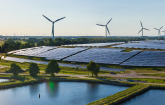DOE and SoCalGas Fund Project That Uses Microbes to Convert Carbon Dioxide to Renewable Natural Gas
Lawrence Livermore National Labs and Stanford School of Engineering's Spormann Laboratory will study new technology with potential to significantly reduce the cost of producing renewable natural gas and reduce carbon dioxide emissions
LOS ANGELES, Aug. 1, 2018 /PRNewswire/ -- Southern California Gas Co. (SoCalGas) today announced grant funding has been awarded to Lawrence Livermore National Laboratory and Stanford School of Engineering's Spormann Laboratory to conduct new power-to-gas research. The two entities will receive $800,000 from the U.S. Department of Energy (DOE). SoCalGas will provide co-funding of $400,000 in addition to $125,000 of seed funding it provided in 2017.
The initiative will research the use of microbes to convert carbon dioxide directly to methane using renewable electricity, a process known as microbial electromethanogenesis (ME). If developed as envisioned, ME could become a highly efficient, large-scale storage technology for excess wind and solar energy. This would, in turn, make both renewable electricity and renewable natural gas less expensive and more plentiful.
The research will continue past research by Spormann Laboratory on microbes that create methane, as well as advances in 3D-printed carbon aerogel electrode materials made by LLNL, which will be assessed for their viability in reactors. Biogas will be supplied by Delta Diablo, a Livermore, Calif., wastewater treatment plant. Raw biogas is mostly methane, but also contains about 30 to 40 percent carbon dioxide, which is typically vented to the atmosphere in a biogas production facility.
"This technology has the potential to cut the cost of processing biogas, while nearly doubling the amount of this easily-stored renewable energy and reducing carbon dioxide emissions," said Yuri Freedman, SoCalGas senior director of business development. "It could make a big difference for smallscale biogas producers like dairy farms and feedlots, which collectively make up the majority of California's renewable natural gas potential."
SoCalGas provided funding to this research to further develop the technologies known as power-to-gas (P2G), which stores excess renewable electricity as renewable gas rather than in conventional batteries. Power-to-gas has two distinct advantages over batteries: nearly unlimited amounts of electricity can be easily stored for very long periods of time, and it can be stored and used with existing infrastructure.
"Through this project we intend to devise scalable, efficient prototype reactors that enable both economical upgrading of biogas and storage of renewable electricity as methane," said LLNL chemist Sarah Baker. "To do this, we will leverage recent advances in materials synthesis and manufacturing to fabricate reactors tailored to the requirements of the microbes and the overall process."
Between 3,300 and 7,800 gigawatt-hours of excess solar and wind energy will be curtailed in California by 2025 due to time-of-day supply/demand mismatches, according to a recent Lawrence Berkley National Lab study. If that excess solar and wind energy were converted to methane and stored as renewable natural gas, it would provide enough renewable energy to heat 158,000 to 370,000 homes or provide renewable electricity to 80,000 to 187,000 homes.
Capturing methane and carbon dioxide from farms, wastewater treatment plants and landfills and then delivering it through existing pipelines is a cost-effective option to reduce greenhouse gas emissions. A recent analysis found that California could achieve the same greenhouse gas reductions as electrifying buildings at a much lower cost by replacing just a fraction of the natural gas delivered through its pipelines with renewable natural gas.
The University of California at Davis estimates that the natural gas needs of around 2.4 million California homes could be fueled with renewable natural gas derived from the state's existing organic waste. Already, 60 percent of the fuel used in natural gas vehicles in California is renewable, and SoCalGas expects that to increase to 90 percent by 2019.
Technological advances like power-to-gas and renewable natural gas can reduce greenhouse gas emissions while providing energy resiliency and meeting consumers' fuel preferences. Across Southern California, people prefer natural gas four to one over electricity because it is more affordable and reliable, and more than 90 percent of residents use natural gas in their homes.
The research will be conducted at both LLNL and Stanford School of Engineering beginning in August, and is expected to be complete by mid-2020.
About SoCalGas
Headquartered in Los Angeles, SoCalGas® is the largest natural gas distribution utility in the United States. SoCalGas delivers affordable, reliable, clean and increasingly renewable natural gas service to 21.7 million customers across 22,000 square miles of Central and Southern California, where more than 90 percent of residents use natural gas for heating, hot water, cooking, drying clothes or other uses. Natural gas delivered through the company's pipelines also plays a key role in providing electricity to Californians—about 60 percent of electric power generated in the state comes from gas-fired power plants.
SoCalGas is committed to investing in its natural gas system infrastructure, while keeping bills affordable for our customers. From 2013 through 2017, the company spent nearly $6 billion to upgrade and modernize its natural gas system to enhance safety and reliability. The company is also committed to being a leader in the region's clean energy future, and is working to accelerate the use of renewable natural gas from dairy farms, landfills and wastewater treatment plants and the development of renewable energy storage technologies. SoCalGas is a subsidiary of Sempra Energy (NYSE: SRE), a Fortune 500 energy services holding company based in San Diego. For more information visit socalgas.com/newsroom or connect with SoCalGas on Twitter (@SoCalGas), Instagram (@SoCalGas) and Facebook.
About LLNL
Founded in 1952, Lawrence Livermore National Laboratory (www.llnl.gov) provides solutions to our nation's most important national security challenges through innovative science, engineering and technology. Lawrence Livermore National Laboratory is managed by Lawrence Livermore National Security, LLC for the U.S. Department of Energy's National Nuclear Security Administration.
SOURCE Southern California Gas Company
Related Links
WANT YOUR COMPANY'S NEWS FEATURED ON PRNEWSWIRE.COM?
Newsrooms &
Influencers
Digital Media
Outlets
Journalists
Opted In






Share this article